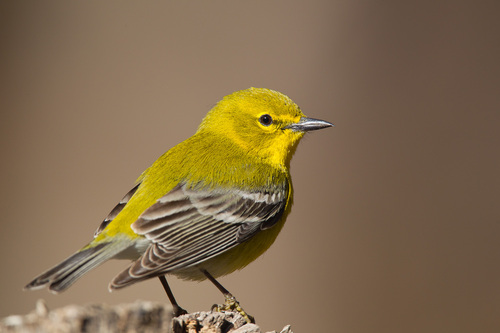
Pine Warbler
The Pine Warbler (Setophaga pinus) is a small, active songbird native to North America, known for its preference for pine forests. Unlike many other warblers that are primarily insectivorous, the Pine Warbler incorporates a significant amount of pine seeds into its diet, especially during the winter months. This adaptation allows it to occupy a niche with less competition from other warbler species. It plays an important ecological role in seed dispersal and insect control within its preferred habitat. While not currently considered globally threatened, habitat loss poses a potential future risk.
12-14 cm
Length
20-23 cm
Wingspan
Least Concern
Conservation Status
Distribution
Eastern North America, from southeastern Canada (southern Ontario, Quebec) south to Florida and west to eastern Texas and Oklahoma. Some populations are resident year-round, while others migrate short distances to the southern United States and parts of the Caribbean.
Lifespan
Average lifespan in the wild is 2-3 years, but some individuals may live longer.
Pine Warbler's Habitat
Habitat Types
Pine forests, Mixed pine-hardwood forests, Pine savannas
Climate Zones
Temperate, Subtropical
Adaptations
Strong legs and feet for foraging on pine branches and cones. Their relatively stout bill is well-suited for extracting seeds from pine cones.
Variations
Four subspecies are generally recognized, differing slightly in plumage and size, primarily based on geographic location: *S. p. pinus*, *S. p. florida*, *S. p. achrustera*, and *S. p. chrysoleuca*.
Appearance
Breeding Plumage
Males in breeding plumage have brighter yellow throats and breasts, with olive-green upperparts and two white wing bars. Non-breeding males and females are duller, with less yellow and more olive-brown coloration.
Seasonal Feather Changes
Plumage becomes brighter during the breeding season (spring and summer) and duller in the fall and winter.
Sex Based Plumage Differences
Males are generally brighter yellow than females, especially during the breeding season.
Notable Features
Two prominent white wing bars, Yellowish throat and breast (brighter in breeding males), Unstreaked, olive-green back
Diet and Feeding
Primary Foods
Insects, Spiders, Pine seeds, Berries, Other seeds
Foraging Behavior
Forages actively in pine trees, gleaning insects and spiders from needles and branches. Also probes pine cones for seeds, and occasionally forages on the ground.
Specializations
The bill is slightly heavier and more robust than many other warblers, allowing it to efficiently extract seeds from pinecones.
Seasonal Diet Variations
Diet shifts with insect availability. Insects and spiders are the primary food source during the breeding season, while pine seeds become more important in the fall and winter.
Behavior
Social Structure
Generally solitary or found in pairs during the breeding season. May form small flocks during migration and winter.
Communication
A rapid, trilling song, often described as a musical *trill*, Sharp *chip* call notes, Soft *seet* contact calls
Migration
Some populations are resident, while others undertake short-distance migrations. Northern populations move south for the winter, often to the southeastern United States.
Territorial or Group Behaviors
Males defend territories during the breeding season through song and aggressive displays. Outside of the breeding season, they are less territorial.
Conservation
Threats
Habitat loss (loss of mature pine forests), Habitat fragmentation, Pesticide use (reducing insect prey)
Protection Programs
Sustainable forestry practices, Habitat restoration projects
Local National Laws
Protected under the Migratory Bird Treaty Act in the United States.
Population Trend
Stable
Population Estimates
The global population is estimated to be around 13 million individuals.
Interesting Facts
Pine Warblers are one of the earliest warblers to arrive on their breeding grounds in the spring.
Their ability to utilize pine seeds allows them to survive even when insect populations are still low.
They often forage lower in trees than many other warbler species.
This reduces competition with other insectivorous birds.
Pine Warblers sometimes visit bird feeders, especially for suet and sunflower seeds.
This behavior is more common during the winter months when natural food sources are scarce.
Faqs about Pine Warbler
What is the best way to attract Pine Warblers to my yard?
Planting pine trees and providing a source of suet or sunflower seeds can help attract Pine Warblers, especially during the winter.
How can I tell a Pine Warbler from other warblers?
Look for the combination of two white wing bars, a yellowish throat and breast (brighter in males), and an unstreaked olive-green back. Their trilling song is also distinctive.
Are Pine Warblers endangered?
No, Pine Warblers are currently classified as Least Concern by the IUCN. However, habitat loss is a potential threat.
Copyright @ Nature Style Limited. All Rights Reserved.
 English
English